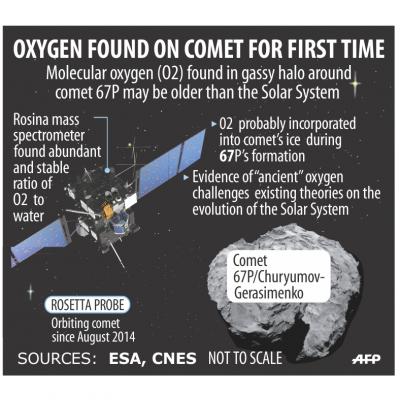-
Tips for becoming a good boxer - November 6, 2020
-
7 expert tips for making your hens night a memorable one - November 6, 2020
-
5 reasons to host your Christmas party on a cruise boat - November 6, 2020
-
What to do when you’re charged with a crime - November 6, 2020
-
Should you get one or multiple dogs? Here’s all you need to know - November 3, 2020
-
A Guide: How to Build Your Very Own Magic Mirror - February 14, 2019
-
Our Top Inspirational Baseball Stars - November 24, 2018
-
Five Tech Tools That Will Help You Turn Your Blog into a Business - November 24, 2018
-
How to Indulge on Vacation without Expanding Your Waist - November 9, 2018
-
5 Strategies for Businesses to Appeal to Today’s Increasingly Mobile-Crazed Customers - November 9, 2018
Oxygen discovered on Rosetta comet, stunning scientists
Scientists from the Rosetta mission have found oxygen in the atmosphere of comet 67P/Churyumov-Gerasimenko, a discovery that could change our understanding of how the solar system formed.
Advertisement
In a major breakthrough, European Space Agency’s (ESA) Rosetta spacecraft has made the first in-situ detection of oxygen (O2) molecules outgassing from a comet, a surprising observation that suggests they were incorporated into the comet during its formation, according to an announcement by the space agency on Thursday.
Top middle: high-resolution measurements allowed molecular oxygen (O2) to be distinguished from other species like sulphur (S) and methanol (CH3OH). Now, the researchers are hoping the coma, gas cloud surrounding the comet, could also contain carbon dioxide, water and carbon monoxide.
“It was a big surprise to actually detect the O2”, says Andre Bieler, who co-led the study concerning the comet’s trail of gas.
Oxygen in its two-atom form is very hard to track down in the universe, because it is highly reactive and readily breaks apart. This finding has forced space scientists to rethink the ingredients thought to be present during the early days of the solar system. “Everybody and all models showed that molecular oxygen would react with the hydrogen and would no longer be present as molecular oxygen”. This means that even though molecular oxygen may be common in other comets, there is no way yet to confirm that theory. Yet each time the comet orbits the sun, it sheds between one and 10 meters from its circumference.
In this latest study, the researchers used findings from the ROSINA mass spectrometer on the Rosetta space probe. The first: What conditions were necessary for molecular oxygen to get trapped in the icy crystals of a comet like 67P? Studying comets and their chemical composition provides researchers rare opportunities to study the antecedents of the solar system.
The new data suggests that water on comets is probably the rule rather than the exception, the scientists said.
Advertisement
“The cometary community has always said that comets are a few of the least-processed bodies in the solar system”, Bieler said. A few theories speculated that the solar system formed through violent collisions of matter, but frozen oxygen could not have escaped intact the collisions.




























